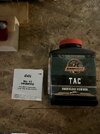Nature Boy
Member
- Joined
- Apr 21, 2015
- Messages
- 8,296
@DMW1116
Any reloading information source is data, be it published in a book or from Internet forums like this. They each have their value but personal experience trumps all.
I may use a combination of source data to start the load development process but once I’m at the range and send the first round into a target my observations take precedence over any information in a reloading manual or advice from the internet.
Any reloading information source is data, be it published in a book or from Internet forums like this. They each have their value but personal experience trumps all.
I may use a combination of source data to start the load development process but once I’m at the range and send the first round into a target my observations take precedence over any information in a reloading manual or advice from the internet.


